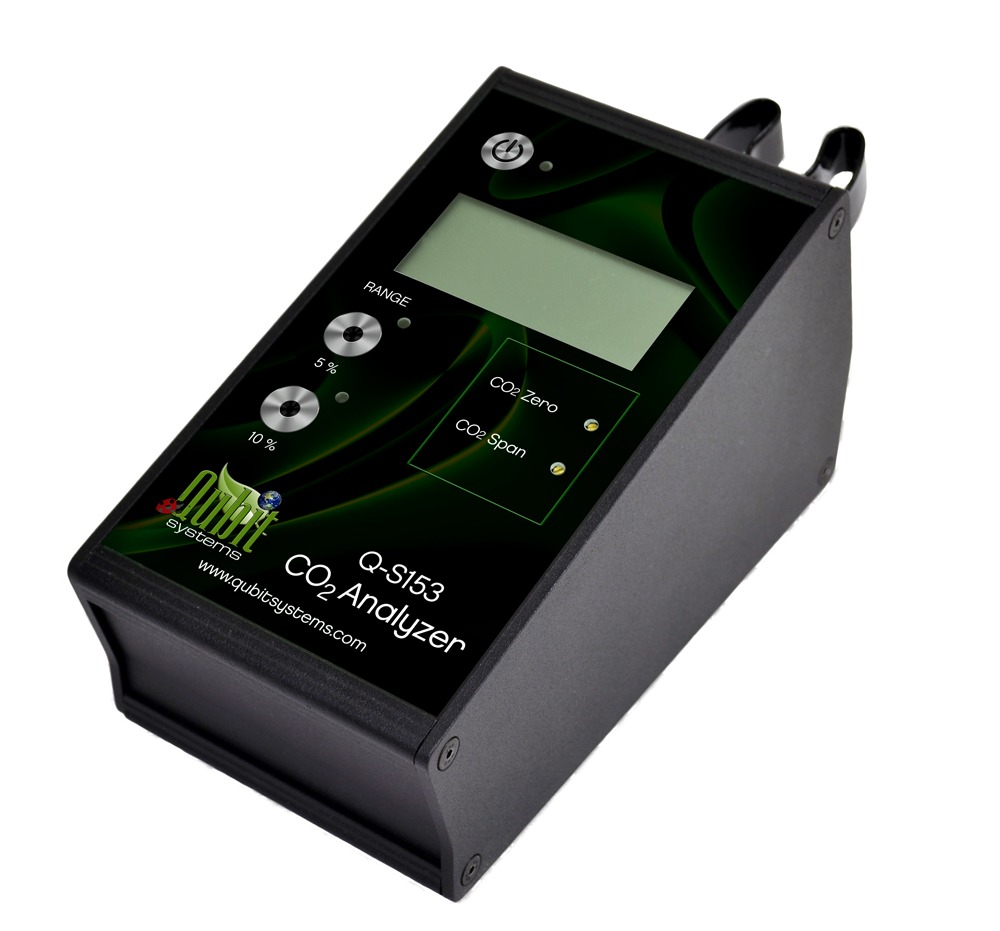
Q-S153 CO2 Analyzer is a single channel non-dispersive infrared CO2 analyzer which measures CO2 in 0 to 5% and 0 to 10% range with 0.01% resolution. Q-S153 replaces our S153 CO2 Analyzer. The same dependable technology has been improved, made more rugged and modular for easy fit in our Q-Box Packages. Q-S153 CO2 analyzer is ideal for CO2 exchange measurements in larger or more active animals and in situations where high CO2 fluxes may occur, such as fermentation processes, human respirometry. Q-S153 may be used in a flow-through gas exchange configuration for instantaneous and continuous measurements of CO2 exchange or as part of Qubit Systems’ carbon dioxide control system for regulating pCO2 in growth cabinets and rooms.
Packages that include Q-S153 CO2 Analyzer:
- Q-Box HR1LP Human Respirometry Package
- Q-Box RP2LP High Range Respiration Package
- Switchable ranges of 0 – 5% and 0 – 10% CO2
- 0.01% CO2 resolution on digital display
- Non-dispersive infrared technology
- Modulated infrared light source = no moving parts
- 0 – 5 V analog output at both range settings
- Optional battery pack for field use
- Compact and portable
- Respirometry in mammals
- Exhaled air analysis in humans
- Compost monitoring
- Monitoring of anaerobic metabolism in yeast colonies
- Operating principle: Non-dispersive infrared
- Gas sampling mode: Flowing gas stream, sealed chamber
- Maximum gas flow rate: 650 mL/min
- Measurement range (LCD display): 0 – 10%
- Analog output, low sensitivity: 0 – 10%
- Analog output, high sensitivity: 0 – 5%
- Accuracy: ± 0.3% of full scale
- Repeatability: Better than ±1%
- Maximum drift (per year): ±0.5%
- Response time (@ 250 mL/min; to 95% of final value): ca. 20 sec
- Warm up time 5 min
- Output (linear) for Low Sensitivity setting: 0 – 5 VDC for 0 –10%
- Output (linear) for High Sensitivity setting: 0 – 5 VDC for 0 – 5%
- Calibration adjustments: Zero and Span
- Operating temperature range: 0 to 50C
- Storage temperature range: -40 to 70C
- Operating pressure range: ±1.5% local mean pressure
- Humidity range: 5 to 95% RH, non-condensing (recommend drying gas stream)
- Pressure dependence: +0.19% reading per mm Hg
- Power requirements: 12 VDC via 120 VAC/60 Hz adapter
- Current requirements: 175 mA average, 450 mA peak
- Dimensions (cm): (H x W x D: 5.5 to 9.5 x 9.5 x 17)
- Weight: 1 kg
- Warranty: 1 year limited
- Mathew B. Sonier and Harold G. Weger. Plasma membrane ferric reductase activity of iron-limited algal cells is inhibited by ferric chelators. Biometals (Online May 2010).
- Nikki L. Wirtz, Ron G. Treble and Harold G. Weger. Siderophore-Independent Iron Uptake By Iron-Limited Cells Of The Cyanobacterium Anabaena Flos-Aquae. Journal of Phycology Vol 46, Issue 5, p947–957 (2010).
- Christine E. Cooper and Philip C. Withers. Comparative physiology of Australian quolls (Dasyurus; Marsupialia). Journal Of Comparative Physiology B: Biochemical, Systemic, And Environmental Physiology Vol 180, Number 6, p857-868 (2010).
- Weger, Harold G.; Lam, Jackie; Wirtz, Nikki L.; Walker, Crystal N.; Treble, Ron G. High stability ferric chelates result in decreased iron uptake by the green alga Chlorella kessleri owing to decreased ferric reductase activity and chelation of ferrous iron. Botany, Vol 87, Number 10, p922-931 (2009).
- Christine Elizabeth Cooper and Ariovaldo P. Cruz-Neto. Metabolic, hygric and ventilatory physiology of a hypermetabolic marsupial, the honey possum (Tarsipes rostratus). Journal Of Comparative Physiology B: Biochemical, Systemic, And Environmental Phys Vol 179, Number 6, p773-781 (2009).
- Harold G. Weger, Crystal N. Walker and Michael B. Fink. Ferric and cupric reductase activities by iron-limited cells of the green alga Chlorella kessleri: quantification via oxygen electrode. Physiologia Plantarum Vol 131, Issue 2, p322–331 (2007).
- Sophie de Seigneux, Hans Malte, Henrik Dimke, Jørgen Frøkiær, Søren Nielsen, and Sebastian Frische. Renal compensation to chronic hypoxic hypercapnia: downregulation of pendrin and adaptation of the proximal tubule. Am J Physiol Renal Physiol Vol 292 Number 4, p1256-1266 (2007).
- Yinghao Yu, Juliana A. Ramsay and Bruce A. Ramsay. On-line estimation of dissolved methane concentration during methanotrophic fermentations. Biotechnology and Bioengineering Vol 95, Issue 5, p788–793 (2006).
- Stephen E. MacAvoy, Lynne S. Arneson and Ethan Bassett. Correlation of metabolism with tissue carbon and nitrogen turnover rate in small mammals. Oecologia Vol 150, Number 2, p190-201 (2006).
- Cameron R. Ralph, Richard D. Reina, Bryan P. Wallace, Paul R. Sotherland, James R. Spotila and Frank V. Paladino . Effect of egg location and respiratory gas concentrations on developmental success in nests of the leatherback turtle, Dermochelys coriacea Australian Journal of Zoology Vol 53, Issue 5, p289–294 (2005).
- R. W. Gusztak, R. A. MacArthur and K. L. Campbell. Bioenergetics and thermal physiology of American water shrews ( Sorex palustris). Journal Of Comparative Physiology B: Biochemical, Systemic, And Environmental Phys Vol 175, Number 2, p87-95 (2005).
- Hoffmann, Eric J.; Miller, James R. Reassessment of the Role and Utility of Wind in Suppression of Mosquito (Diptera: Culicidae) Host Finding: Stimulus Dilution Supported Over Flight Limitation. Journal of Medical Entomology, Vol 40, Number 5, p607-614 (2003).
Testimonial
“I have been very impressed with the value and quality of our Qubit Systems’ laboratories. Their simplicity of design allows students to understand the processes they are measuring better than our more elegant expensive portable photosynthesis machine.
We plan to take your CO2 system, with portable pump and battery to the tropics this spring for a field course – a trip we are not brave enough to take our $18,000 machine on!”
Dr. Judy Parrish, Millikin University, Decatur, Illinois

